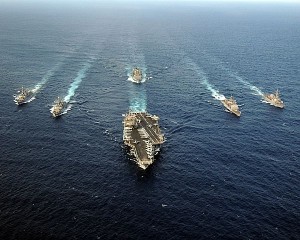 In a paroxysm of hand-wringing and rending of garments, the U.S. Navy changed the way it counts the battle fleet, growing the active fleet a bit, to 290.
In a paroxysm of hand-wringing and rending of garments, the U.S. Navy changed the way it counts the battle fleet, growing the active fleet a bit, to 290.
Most observers were outraged, sensing the Navy was using an accounting gimmick to grow the fleet. But…I wasn’t too upset. Like most of my readers, I am concerned about the shrinking American Navy. But…What’s a few extra ships here or there? Is the situation really that bad? Do we have a peer? Or even a near-peer? Yet, anyway?
To get action and attention, the Naval Vessel Register’s fleet count has long been the centerpiece for those fretting about America’s decaying naval forces. And, even though I am concerned about Fleet Size, I sense the fear-mongering is backfiring. I mean, some of Washington’s dire, apocalyptic-sounding handwringing seem to be doing little more than tempting others to underestimate the American Navy’s strength and, ultimately, challenge the Navy at sea.
Fear is no way to approach the world-wide growth in modern naval forces. Challenge at sea is something that America must manage. Coldly. Calmly. Smartly.
That task starts with understanding the size of the fleet. I think that the ship-counting change should be embraced–and we should extend this ship-counting change to account for the total number of ships in the US Fleet–the whole U.S. Fleet. All of it. The National Fleet.
Background:
Here’s a bit of background: With the ostensible intent to help the public/policymakers better understand the Navy contribution to the National Fleet, the Navy changed the ship counting rules from this to this. And, of course, the usual subjects are in a tizzy over it all. Here’s a sample of how some are reacting, from Defense News:
“I am disappointed to see the Navy is now counting ships like patrol craft and hospital ships in its battle force fleet that only a year ago it chose not to count,” said Rep. Randy Forbes, R-Va., chairman of the House seapower subcommittee.
“As well, I do not believe that a ship put in a reduced status should be counted,” Forbes added. “With America’s national security budget under severe pressure, it is imperative that the Congress and the American people be able to visualize just how radically sequestration is impacting American naval strength.”
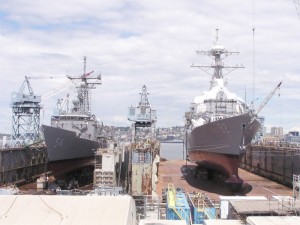 Look. Everyone in Washington–from the Navy on down–has, for years, done a miserable job of explaining what Fleet Size actually means. To some extent, the battle force numbers we use to evaluate the fleet are imprecise, and don’t give an entirely accurate snapshot of America’s total useful force at sea.
Look. Everyone in Washington–from the Navy on down–has, for years, done a miserable job of explaining what Fleet Size actually means. To some extent, the battle force numbers we use to evaluate the fleet are imprecise, and don’t give an entirely accurate snapshot of America’s total useful force at sea.
We can do a better job counting the total fleet, and use that number to urge a better-funded Navy WHILE ALSO serving as a means to detail to potential rivals our overwhelming supremacy at sea.
America Can Do A Better Job Counting:
Don’t believe me? I’ll turn to Bob Work’s old 2008 CSBA “Strategy for the Long Haul” study on Naval futures to illustrate my point:
“…the current ship-counting rules are artifacts from the sea-control century, and need to be updated. Secretary John Lehman last modified them in the early 1980s as he strove to build the “600-ship Navy.” In essence, he decided that only ships that would contribute toward the 600-ship goal would be those immediately available for fleet action against the Soviet Union and the Soviet Navy.”
 That’s all well and good, but even John Lehman’s “fleet action” oriented counting scheme failed to account for, say, ships undergoing long overhauls.
That’s all well and good, but even John Lehman’s “fleet action” oriented counting scheme failed to account for, say, ships undergoing long overhauls.
Who among us (Yes, Congressman Forbes, I’m talking to YOU here…) thinks that CVN-72, in the midst of a three-year refueling, is actually a functional member of the battle fleet? Or that CVN-69 and CVN-74, each in the middle of 14-month-long refits, are valid combat assets?
They’re not.
So that might lead us to argue that the total battle force number should be somewhat fluid, accounting for, say, the proposed consignment of half our existing CGs to an ‘in ordinary’ like status.
That might not be wise.
While it may be smart for the Navy to use “battle-ready” numbers to, oh, remind policymakers that a 10 CVN-Navy is not really an 10-CVN battle-ready force, and for tacticians to know exactly how many Navy ships are really “Ready to Fight Tonight”, the enumeration of commissioned battle assets (irregardless of condition) remains a useful shorthand to describe naval strength.
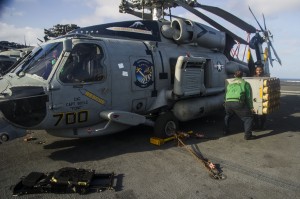 But Work continued (and as we may be seeing in the current re-jiggering of naval fleet-counting rules in SECNAVINST 5030.8B) to press for a modification of the fleet-counting rules:
But Work continued (and as we may be seeing in the current re-jiggering of naval fleet-counting rules in SECNAVINST 5030.8B) to press for a modification of the fleet-counting rules:
“These [Fleet Action-oriented] counting rules are a poor fit for the new, post-Cold War, two-war standard, which requires the Navy to support the entire joint force in addition to performing naval fire and maneuver. With the publication of the new maritime strategic concept, these rules are even more anachronistic. Under this concept, a Coastal Patrol ship building partnership capacity in the Gulf of Guinea or a hospital ship on a mission of peace are as important as an aircraft carrier launching strikes against a rogue state. Since all these ships contribute to overall Navy capability and capacity, they should now be included…”
This is at the heart of the new ship-counting rules, and, to some extent, I agree with this.
Why The New Rules Work:
The first reason I like Robert Work’s suggestion of a “broader” fleet concept is that it adds real functional granularity to a raw “number of ships” figure. It gives outside observers a better idea of just what the Navy is up to.
Also, by including a wider variety of ships in the battle fleet–essentially raising the profile of some little-known, under-appreciated ships–it helps spur the imagination, and may help increase the demand of oft-ignored-yet-critical non-front-line/battle-train vessels (nothing builds demand like evidence somebody else wants it, right?). This is why I quite like the codicil in the new counting rules that allow the inclusion of ships that are “routinely requested by a combatant commander.”
The next reason I like the new fleet-counting rule is that it gives the CNO and SECNAV some flexibility to “hide” ships in training status, and, via bureaucratic legerdemain, possibly grants the Navy a chance to keep some higher-value ships active and off the books someplace (I’m thinking of the old USS Wisconsin (BB-64), which was kept alive as a Naval Academy Training Ship for awhile). Regardless of the ultimate intent, anything that gives the Navy leadership some extra breathing room is, in these days, quite helpful.
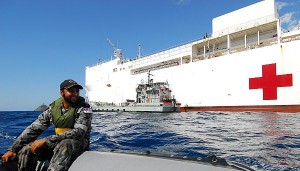 These new counting rules also raise the stakes on those foolish sequester-minded folks eager to cut the fleet. Let me put it this way–during the ’90s draw-down, the U.S. Navy shuffled logistical support fleets off to an ignored, uncounted corner of the non-combat fleet, making those ships quite easy to eliminate (or, at best, really hard to replace). By now counting some of these auxiliary ships, and including them in the active fleet, these vessels suddenly get more consideration before getting the chop.
These new counting rules also raise the stakes on those foolish sequester-minded folks eager to cut the fleet. Let me put it this way–during the ’90s draw-down, the U.S. Navy shuffled logistical support fleets off to an ignored, uncounted corner of the non-combat fleet, making those ships quite easy to eliminate (or, at best, really hard to replace). By now counting some of these auxiliary ships, and including them in the active fleet, these vessels suddenly get more consideration before getting the chop.
Think about it. Why is the SECNAV just now folding the 40-year-old, cantankerous and slimly-justifiable hospital ships into the fleet numbers? It is because he is thinking strategically–the DOD now can’t cut the aged hospital ships without risking a Congressional battle over fleet size. And, in addition, the SECNAV has now effectively enabled and sanctioned an urgent discussion of what might replace these vessels (MLPs with a hospital module? AFSB? A hospital ship LPD-17? Who knows?).
It’s quite a savvy move, and I think even John Lehman would approve.
 (An aside…Many of my readers may find the SECNAV’s naming schemes annoying, but, at the end of the day, SECNAV’s political acumen is somewhat under-appreciated. I think he will leave the Navy in a far better place than where it was when he arrived on station.)
(An aside…Many of my readers may find the SECNAV’s naming schemes annoying, but, at the end of the day, SECNAV’s political acumen is somewhat under-appreciated. I think he will leave the Navy in a far better place than where it was when he arrived on station.)
As much as I approve of the idea of bending a metric to serve the needs of the fleet, we need to acknowledge that this transforms Fleet Size from a metric to more of a navy-centric political tool–and that shouldn’t be why we count the fleet.
What Does Not Work:
What I don’t like about this new counting scheme is that it is something of a beauty contest. While it counts the combatants, it only captures those non-combat ships that are requested and delivered to Combat Commanders at the CNO/SECNAV’s discretion.

This leads to some strange oversights–like the exclusion of the Westpac Express, a forward-deployed ferry that has provided Asia-Pacific theatre mobility support for over a decade. And I’ll bet that the Special Operator Support ships MV C-Champion and her sister are in sufficient demand to warrant inclusion on the fleet list.
There is no indication of what requests were not met nor does this current scheme capture those ships that were not requested but were available. As it is today, the counting scheme gives observers something of an idea of what the Navy is “doing”, but falls short of truly enumerating the true total size of America’s Navy.
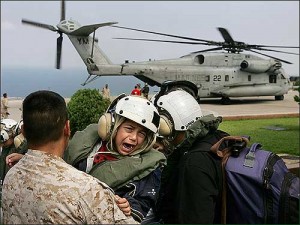 It would be very interesting for the public and policymakers to learn–at maybe the broad 10,000-ft level–just what ship types Combat Commanders actually requested.
It would be very interesting for the public and policymakers to learn–at maybe the broad 10,000-ft level–just what ship types Combat Commanders actually requested.
I’m simplifying here, but do Combat Commanders request, say, CVN battle groups or other powerful combat assets, or do they just sort of show up in their AOR and get used for little reason beyond…they have a schedule and are available (leading to horrible mis-appropriations of resources like, say, a Virginia Class sub sitting for month watching drug smugglers or a DDG dispatched to do harbor security duties). Those bits of data would be very helpful in selling future naval requirements and in informing future procurement. These new counting rules try to do that, but they don’t go far enough.
But, again, if the intent is to provide an accurate counting of fleet strength, these new rules don’t quite cut it.
Count The National Fleet:
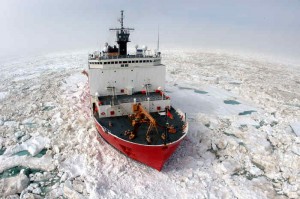 As I said earlier, we need to accurately express the true size of the U.S. National Fleet.
As I said earlier, we need to accurately express the true size of the U.S. National Fleet.
But what does “National Fleet” mean? Well, let me turn to Robert Work again (from the same Strategy for the Long Haul Report):
“There is a simple way to remedy these accounting errors: keep track of the ship target for a truly integrated and interoperable National Fleet, to include the maritime capabilities and capacities of the US Navy, US Marine Corps, US Coast Guard, Military Sealift Command, and the nation’s Ready Reserve Force of sealift ships. The overall National Fleet ship count would include the Total Force Battle Network ship count [provided in the paper], augmented by any Coast Guard vessel capable of deploying overseas in support of US objectives or a joint campaign. At a minimum, this would include all forty Coast Guard high and medium-endurance cutters, as well as 120 coastal patrol cutters and boats able to conduct maritime security operations in forward theaters. This would result in a National Fleet of 583 ships/units. If including smaller Navy and Coast Guard vessels that contribute to US homeland defense and forward security missions, the National Fleet would easily number over one thousand ships, boats, and craft.”
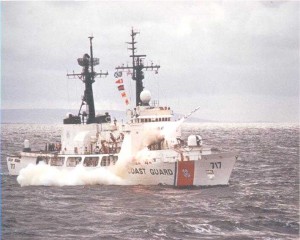 This is something we must do–at a DOD level or Administration/National Security Council level or someplace. Produce an annual measure of NATIONAL FLEET strength, and then work to coordinate, align assets and encourage all the various national fleets (The Navy/MSC, Coast Guard, Maritime Administration Ready Reserve Force, The Army (And Corps of Engineers and Space/SDI Command), NOAA and Customs/Homeland Security) to coordinate–and work together to help fully utilize available resources, investing in interoperable, mutually-supportive resources that make the most strategic sense going forward.
This is something we must do–at a DOD level or Administration/National Security Council level or someplace. Produce an annual measure of NATIONAL FLEET strength, and then work to coordinate, align assets and encourage all the various national fleets (The Navy/MSC, Coast Guard, Maritime Administration Ready Reserve Force, The Army (And Corps of Engineers and Space/SDI Command), NOAA and Customs/Homeland Security) to coordinate–and work together to help fully utilize available resources, investing in interoperable, mutually-supportive resources that make the most strategic sense going forward.
But that takes real strategic drive.
Here’s some suggestions:
FIRST, if we are going to count the fleet, I think it would be wise to look to two of CNO Greenert’s three tenets: “Warfighting First” and “Be Ready”. With that goal in mind, the National Security Council (as the ultimate arbiter between all the agencies providing National Fleet Assets) should, on a quarterly basis, enumerate all the National Fleet ships that are, in the CNO’s and SECNAV’s informed judgement, “able to fight tonight.” Such a count (and I wouldn’t release it immediately–I’d build in some lag before reporting) would provide a measure of the raw, immediate combat power available to policymakers (while also supporting the larger–and somewhat shocking-idea of a “Joint” Fleet).
SECOND, there should be another set of Navy numbers detailing the size of the commissioned battle fleet–enumerating the number and type of ships that are in the battle fleet but not necessarily ready to fight–along the lines of what the NVR is doing today.
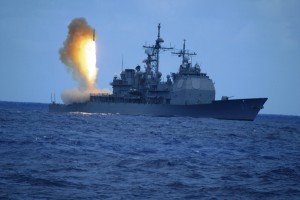 THIRD, there should be an annual functional fleet count–providing the total number of National Fleet ships, broken down by type and by simple status (let’s say “active–achieving one or more embarked missions over the year”, “inactive-maintenance”, and “inactive-reserve”). There should be a few other simple status measures: Ships that have provided service to an agency outside their host service should be identified, as well as those who have provided service outside U.S. territorial waters (and maybe one extra measure determined by the host agency/service).
THIRD, there should be an annual functional fleet count–providing the total number of National Fleet ships, broken down by type and by simple status (let’s say “active–achieving one or more embarked missions over the year”, “inactive-maintenance”, and “inactive-reserve”). There should be a few other simple status measures: Ships that have provided service to an agency outside their host service should be identified, as well as those who have provided service outside U.S. territorial waters (and maybe one extra measure determined by the host agency/service).
And FOURTH–outside of counting, the Administration should provide an annual report of how the Nation is progressing in making the National Fleet a cohesive, interoperable, and mutually-supportive REALITY.
These measures would be very helpful in identifying both the total size of the National Fleet, and identifying (in a broad, 10,000 ft level) what those ships are doing. It would give policymakers a good idea of what America has available, and sets the stage for making National Fleet assets relevant–so that they are put to the best strategic use possible.
A valid accounting of available national resources is important. Without data, maritime strategy formulation becomes a reactive, fear-based exercise. I’m tired and fed up with that. Fear has driven America’s strategic choices for far too long, and it is time we put emotion aside, and begin to think–long and hard–about managing the significant maritime challenges ahead.
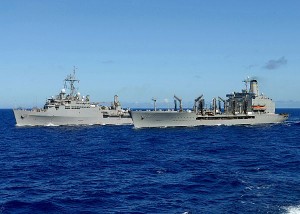

{ 1 comment… read it below or add one }
What bothers me about the change in measuring ship totals isn’t that is a different metric. In 2014 a minesweeper can at times be as valuable as a destroyer in certain circumstances. Ditto a hospital ship.
Navy ship numbers are used by the general public to have an easy handle on the size of the Navy. To me, it’s like the DJIA: the man on the street gets a quick status update of the market, despite the fact that the Average is deceptive and over-simplifying. We can dive into the numbers and calculate average age of ships fleet-wide, VLS, helo spots, and all that; but the public at large wants a simple number. The Dow similarly fails to show market volatility and other trends, but it is used to give the quick answer to how the market is doing.
In my lifetime Reagan may have politicized naval ship numbers the most during his 1980 campaign, but I doubt he was the first President.
I believe some of the reason for the change now is based on political expediency. Navy ship numbers briefly came up in the last presidential election as an issue. The trend is a slight but steady decrease in numbers over the course of the next decade. Adding “new” categories (T-AH, PC, etc.) gives the Navy a bump in the overall total which can hide the slide. Especially when people feel that a 300 ship Navy is a floor.